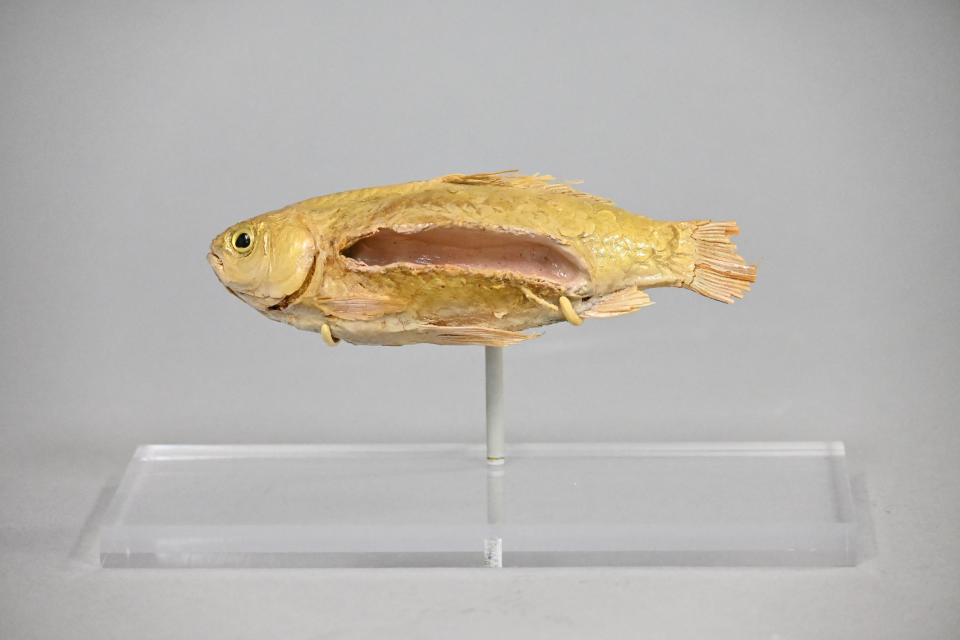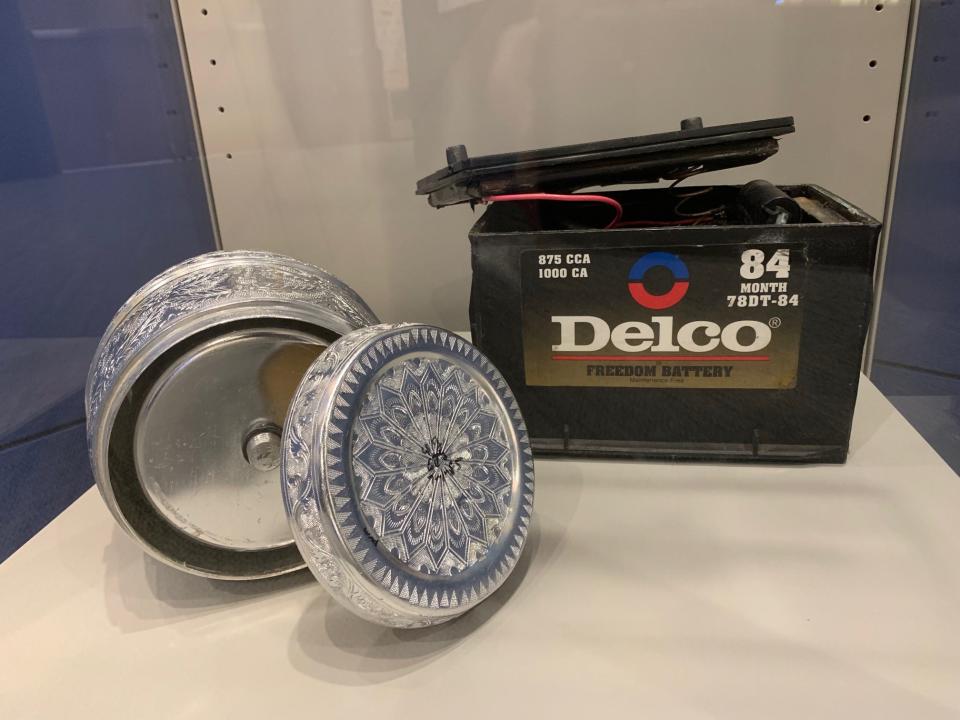Koi fish, bananas and puppies: the ingenious ways smugglers bring illegal drugs into the US
Mexican drug cartel operatives thought they had a clever idea: Smuggle nearly 18 pounds of cocaine into the United States hidden in several large wheels of cheese.
It didn't work. Federal agents busted the operation in July. And in failing, the traffickers join a long line of criminals who try all manner of tactics and techniques to get illicit drugs into the U.S. to make big money.
Because this summer marks the 50th anniversary of President Richard Nixon's establishment of the U.S. Drug Enforcement Administration, USA TODAY is highlighting some of the more ingenious smuggling attempts − and efforts by American drug agents to catch them. Nixon created the drug agency on July 1, 1973, to consolidate the efforts of federal agencies and wage “an all-out global war on the drug menace.”
One of those efforts has been featured in July as the exhibit of the month at the DEA's museum just outside Washington; the 1988 attempt to smuggle heroin from China into the United States by sewing it into live koi fish that were headed for an aquarium in San Francisco.
John Seaman, a now-retired DEA agent who helped crack the koi case, told USA TODAY he and fellow agents spent decades on that kind of a literal cat and mouse game with smugglers. “You ought to see what the Colombians and the Mexicans have done through the years. They've sewn (drugs) into dogs and animals and even kids," Seaman said. "When you get the drug smugglers, they don't give a crap.”
More: Fentanyl killed 70,000 in US. With Biden in Mexico, can neighbors cooperate to stop flow?
But the koi fish case was special, Seaman said, because it marked the first time the DEA worked closely with Chinese authorities to shut down a drug smuggling pipeline. That bilateral effort is virtually nonexistent now, Seaman said, thanks to frosty U.S.-China relations. "But we need to get it back on track to stop the pipeline of fentanyl that's coming into our country and killing tens of thousands of kids."

The koi fish caper
The koi fish caper was first discovered by a Shanghai fisheries employee preparing hundreds of koi − an ornamental variation of the common carp − for shipment to the West Coast. After noticing that several koi floated lifeless at the bottom of huge bags of similar fish, the employee noticed that the dead ones had suspicious stitches along their sides, according to the DEA Museum exhibit and accompanying video.
Chinese authorities were notified, and discovered that this particular fish now on exhibit, along with several others, had an ounce of heroin sewn into their sides. Chinese law enforcement arrested three people and the DEA's office in nearby Hong Kong was brought in.
In a joint operation between DEA and the United States Customs Service, plans were made to allow the fish to be delivered to the aquarium. Agents foiled the plot by electronically tracking the shipment and conducting surveillance. Ultimately, they dismantled a multi-kilo heroin smuggling operation.
"Drug traffickers use whatever means necessary to move illegal drugs around the world. They hide drugs in unsuspecting places like everyday objects and engineer contraptions or strategies to avoid detection from law enforcement," the DEA museum historian, Kasey Sease, says on the DEA video about the current exhibit. "Sadly, they also use people and animals to transport drugs with little concern for theirs safety or lives."
The DEA has had many successes in stopping such attempts.
"But catching drug smugglers isn't easy," says Emma Miller, the museum's technician, on the video. "They constantly invent new ways to move drugs. And law enforcement must adapt to better anticipate and intercept illegal shipments."
Not just smuggling: An upcoming 50th anniversary exhibit
The DEA is readying an exhibit for the museum this October that will celebrate its 50 years of counternarcotics efforts, especially in thwarting the efforts of organized black marketeers to bring in large volumes of drugs like opium and its much stronger derivative, heroin, and later, cocaine and lab-manufactured synthetic drugs like methamphetamine and fentanyl.
The exhibit will rely heavily on the DEA museum and its huge inventory of artifacts from the past half century of the U.S. war on drugs, a term Nixon coined in 1971. Over the decades, DEA constantly has developed new technologies and investigative techniques to spot drug smuggling, just as traffickers come up with new ways to try to evade them. And when agents confiscate drugs using new smuggling tools in the field, they sometimes end up on display in the museum.
More: Blue Lotus, Four Horsemen, Hydra and Pelican Bones: How the US fights the fentanyl crisis
The koi fish is just one of more than 45,000 artifacts, photographs, videos and documents in the museum collection. Each is designed to illuminate important moments in the history of the DEA, its relationship with other law enforcement agencies here and abroad − and drug use in American culture.
Not all of the exhibits focus on drug smuggling. One of the most visibly arresting is a pair of green snakeskin platform shoes worn by undercover agent Doug Wankel in 1970s as he sought to blend in with disco-dancing cocaine traffickers in Detroit. Wankel, who later served in Afghanistan, donated the shoes to the museum when he retired. Another exhibit features many of the kinds of fake pharmaceutical pills containing fentanyl that have been seized.
The DEA also has a series of written chapters that delve into U.S. drug trafficking efforts. One of the earliest includes a photo of two very stern-looking Italian women who allegedly attempted to smuggle 72 ounces of narcotics, "presumably in the spacious folds of their clothes, onboard the S.S. America, an Italian liner docking at Boston." Another shows sealed cans of “Pure de Tomate” tomato puree that contained smoking opium, smuggled into the U.S. by two officials of Mexico's Civil Aeronautics Administration.
More recent exhibits show how smugglers tried to get in drugs hidden in a hollowed-out surfboard, a Delco car battery, a truck tail gate and even an ice bucket with a false bottom.

Bananas, puppies and batteries
Over time, more sophisticated smuggling operations used live animals, and humans, to try and get drugs over the border.
In 2006, Colombian and U.S. authorities broke up a network smuggling heroin into the U.S. by surgically implanting it into pedigree Labrador puppies.
Authorities discovered the ruse when they raided a farm in Colombia and found 10 puppies, including six with abdominal scars. Using ultrasound, they found least 14 packets of liquid heroin sewn into the dogs' bellies by a local vet. Several of the pups later died of infection, and authorities said they didn't know how many had been used by the smuggling operation.
"The organization's outrageous and heinous smuggling method of implanting heroin inside puppies is a true indication of the extent that drug dealers go to make their profit," John Gilbride, head of the DEA's New York office, said in a news release at the time. "This investigation identified the individuals who were responsible for overseeing and smuggling millions of dollars worth of heroin from Colombia to the East Coast."
Ultimately, 22 people were arrested as part of a network that also allegedly used human couriers. Agents also found heroin hidden in moisturizing creams and aerosol cans, pressed into the shapes of beads and stitched into the lining of purses and luggage.
Newer and more creative types of smuggling creativity
In 2016, border agents in Pharr, Texas, intercepted nearly 1,500 pounds of marijuana stuffed inside coconuts being hauled by a tractor-trailer. Months later, the agents seized 4,000 pounds of fake, weed-stuffed limes at the U.S.-Mexico border and, separately, 2,500 pounds of pot-stuffed bogus carrots.
Drug agents in Freeport, Texas, found $18 million in cocaine hidden inside boxes of ripe bananas in 2018 – as well as heroin hidden inside a working car battery, 14,000 pounds of marijuana camouflaged within a melon shipment and fentanyl concealed in a spare tire.
Also in 2018, Francisco Castaneda Rivera was indicted by a federal grand jury for allegedly transporting 4.5 kilograms of heroin − also hidden inside a car battery − from Texas to the Atlanta area.
According to the indictment, law enforcement searched a truck Rivera was riding in and observed that the battery was significantly cleaner than the rest of the engine compartment. Agents opened it and found five packages wrapped in electrical tape along with a motorcycle battery wired to provide electrical current sufficient to operate the vehicle.
Traffickers also were caught trying to smuggle cocaine across the border in hollow iron I beams. "The smugglers assumed that stashing the drugs in a metal casing would prevent detection by x-ray machines," according to a DEA museum exhibit about it. "They were wrong."
'High tech, low tech and everything in between'
And in recent years, smugglers − notably Mexico's Sinaloa and Jalisco New Generation cartels − have been smuggling fentanyl into the U.S. in all manner of products made to resemble candies and pain medication.
Last October, a New Jersey woman was arrested after New York authorities discovered 15,000 pills of "rainbow fentanyl" stuffed inside a Lego box that she was carrying while getting into a vehicle.
Preliminary testing indicated the pills contained fentanyl. Further investigation revealed that 48-year-old Latesha Bush of Trenton, New Jersey, had traveled from New Jersey in a rental car, and the pills allegedly came from Mexico, authorities said. The pills were imprinted with an "M" and a "30" to resemble oxycodone pills.
Smugglers are trying new tactics when smuggling other drugs into the U.S. too. Earlier this year, the Mexican navy said it had intercepted methamphetamine mixed into more than 8,000 liters of bottled tequila, and cocaine mixed with "organic fertilizers."
Jim Crotty, a senior DEA official until his retirement in July 2021 as deputy chief of staff, said fentanyl traffickers are causing significant concern at the highest levels of the U.S. government because of how much is being smuggled in – and how little of the lethal drug it takes to kill someone.
“The profit margins are so huge, but there’s still this kind of intelligence gap,” Crotty said, where U.S. officials don’t know exactly how all of the fentanyl is getting across the border from Mexico, and in what form.
“But one thing we do know,” he said, “is that, as always, they’re going high tech and low tech and everything in between.”
This article originally appeared on USA TODAY: Koi fish, puppies, bananas: ingenious ways smugglers get drugs into US

